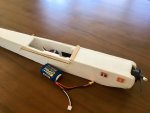This is my modification of the Tiny Trainer.
The Tiny Trainer is a great design except for a few minor things that I found frustrating;
1. Trying to juggle the multipart fuselage was a pain when setting up or doing repairs in the field and
2. The fuselage wasn’t wide enough to fit everything in tidily especially when you threw in a battery alarm and all the servo wires for the four channel wing.
I had no plans to use it as a glider so I modified the fuselage to be one piece.

The wing tie downs can now be glued in place making them stronger and by retaining the width at the nose the rest of the fuselage was wider so there’s plenty of room inside.

The popsicle stick in front of the wing is to strengthen an area that seems to get a lot of damage.
There is enough room for the battery to go inside under the wings.

I expected removing the nose and moving the battery back under the wing would have made it tail heavy but oddly it is a bit nose heavy, at least with my build.
I'm very happy with the mod. It flies well, is easy to work on and seems more resilient to my heavy "landings".
Here's a PDF with the modified fuselage.
Tiny Trainer Mod.pdf
The Tiny Trainer is a great design except for a few minor things that I found frustrating;
1. Trying to juggle the multipart fuselage was a pain when setting up or doing repairs in the field and
2. The fuselage wasn’t wide enough to fit everything in tidily especially when you threw in a battery alarm and all the servo wires for the four channel wing.
I had no plans to use it as a glider so I modified the fuselage to be one piece.

The wing tie downs can now be glued in place making them stronger and by retaining the width at the nose the rest of the fuselage was wider so there’s plenty of room inside.

The popsicle stick in front of the wing is to strengthen an area that seems to get a lot of damage.
There is enough room for the battery to go inside under the wings.

I expected removing the nose and moving the battery back under the wing would have made it tail heavy but oddly it is a bit nose heavy, at least with my build.
I'm very happy with the mod. It flies well, is easy to work on and seems more resilient to my heavy "landings".
Here's a PDF with the modified fuselage.
Tiny Trainer Mod.pdf
Last edited:


